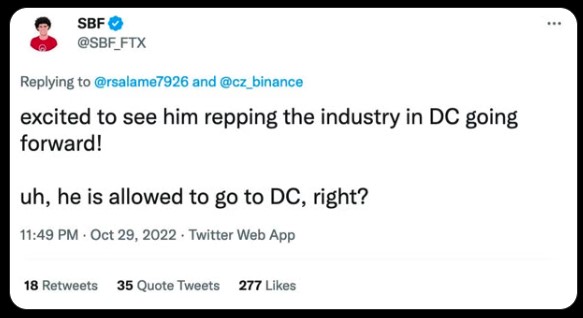Binance Won the War and Became an Empire, Could CZ be the Next Nero?

A storm has been blowing its coldest winds and striking its brightest thunder for the past hours. However, it is not just any, for it is a crypto storm that has turned the tables and changed the course of the game.
Drops in prices, a continuous war between giant rival exchanges, and a whole lot of panic; this is what the past week has been all about.
But why? Why is this happening ? What does it mean to have Binance as a giant and no one to match it in size? What is the role of regulators ? Can we see them stepping in to fight monopoly, which is the case of Google and Facebook with web2.0?
Overview on FTT case
It all started when crypto enthusiasts woke up to CZ wanting to liquidate his exchange’s holdings of FTT, the native token of rival exchange FTX.
CZ mentioned that the decision was taken post “recent revelations that have come to light”, but did not elaborate publicly nor respond to a request for clarification. However, it has been weeks since criticism has been directed at FTX’s founder and Chief Executive Sam Bankman-Fried for regulatory proposals he put forth in a blog post which recommended restrictions regarding DeFi.
Nevertheless, Binance explained in a tweet that the FTT liquidation was post-exit risk management, on account of lessons from the fall of Terra Luna Classic (LUNC),\ and its effect on market participants.
He added that the liquidation is expected to take a few months to complete due to market conditions and limited liquidity, and will also be done in a way that tries to minimize the market impact on FTT. But, did he do so? Not really.
Caroline Ellison, chief executive of Bankman-Fried’s crypto trading firm Alameda Research, highlighted that the balance sheet didn’t provide the entire picture, and the questioned sheet is only for “a subset of their corporate entities” and other assets worth over $10 billion weren’t shown.
She offered to buy Binance’s remaining FTT for a set price of $22 if Zhao was looking to “minimize the market impact” of the move as well, but CZ showed no interest in her offer.
On Saturday, close to 23 million FTT worth around $584 million at the time transferred from an unknown wallet to Binance, which Zhao provided the confirmation as part of the exchange’s token offloading. That is the equivalent of 17% of the circulating supply of FTT.
This being said, FTT has dipped 9.5% to $23.03 from $25.55, reaching around $22 on Sunday.
Nonetheless, it doesn’t stop here, it’s Monday- new week, new drama!
Spooked investors kept pulling assets from the exchange Monday, sending FTT to $15.30, down from $21.90—levels not seen from last February.
With FTT having a market value of $3.88 billion at the time, other digital assets also were hit, with bitcoin and ether dropping 5% and 7%, respectively. The global cryptocurrency market shed 4.6% in total.

FTX appears to have paused processing clients’ requests for withdrawals. According to data from Etherscan, an analytics platform for the EthereumETH –13.8% blockchain, the last transaction was processed more than two hours ago.
Unexpected, isn’t it?
Hours later, CZ announced in a tweet that Binance has signed a nonbinding agreement to buy FTX.com, a unit of major rival FTX, to help cover a “liquidity crunch” at the cryptocurrency exchange.
He tweeted, “This afternoon, FTX asked for our help. There is a significant liquidity crunch. To protect users, we signed a non-binding LOI, intending to fully acquire FTX.com and help cover the liquidity crunch. We will be conducting a full DD in the coming days.”
In a tweet, Sam Bankman-Fried, said that teams are working on clearing out the current backlog of withdrawals and that all assets will be covered 1:1.
With this in mind, FTT was down by 84%, reaching 5$, whereas Bitcoin and Ethereum were both down by 14.3 and 20%, respectively.
The story behind closed doors
It all goes back to years ago when CZ founded Binance, and it quickly grew to become the largest centralized crypto exchange in the world. Since its launch, many exchanges (Coinbase, BitMEX, Gemini, etc.) have unsuccessfully tried to take its crown.
In May of 2019, a new player entered the space when SBF founded FTX.
Immediately, it was clear that this exchange was on another level, as SBF had the smarts and the competitive drive to quickly rise to the top.
Nevertheless, CZ didn’t build the largest crypto exchange by luck. In fact, it is clear that Binance invested in FTX back in 2019 for a reason.
It was also announced that FTX would build institutional product offerings for the Binance ecosystem.
However, as FTX continued to rapidly grow during the last bull market, CZ sensed that they were becoming a threat. That’s why in 2021, Binance chose to divest from FTX during its $900 million funding round.
CZ called it a “normal investment cycle”, but everyone knew it was more.
Fast forward to 2022 and FTX is now the #2 exchange after Binance. While Binance still does 10x the volume of FTX, the rate of growth for FTX is surely alarming to CZ. However, there’s another reason CZ is worried.
It’s no secret that SBF has grand ambitions, and he realized the only way to maximize FTX’s potential is by winning over regulators. That’s why he is one of the biggest donors in not just crypto the industry, but in US politics overall (He was the #2 donor to the Biden campaign).
SBF understands that in order to one day beat Binance, he needs to leverage US politics as a weapon, and he also knows his angle. In fact, CZ was born in China and there are rumors of Chinese involvement with Binance.
As US and China tensions rise, he has an angle to attack Binance.

Of course, CZ is not going down without a fight. And he recently got the opening he needed to strike back.
There were 2 events in particular that opened SBF/FTX up to an attack from CZ/Binance:
1. The first was after SBF published proposals on crypto regulation, which were met with severe backlash from the crypto industry, with many claiming that SBF was trying to kill DeFi and push for regulatory capture. SBF was suddenly an “enemy of crypto”.
2. CoinDesk published a story, which stated that much of the $14.6 billion in assets on the Alameda (FTX’s investing arm) balance sheet, was actually its $FTT token that the company prints itself. This meant that if $FTT price dropped, FTX itself could be at risk.
Regardless of whether or not the financial risks from $FTT were real or not, CZ had the angle he needed to make his attack; as part of the divestment from FTX back in 2021, Binance had received $2.1 billion worth of $FTT & $BUSD. Then CZ went on the offensive:
1. It helped fuel the FUD narratives around FTX insolvency, and it further framed FTX as being against crypto.
2. It would allow Binance to make a material impact on the $FTT price by selling their tokens, leading to all the drama that has been enveloping the space for a few days.
This being said, the strategic brilliance behind CZ’s attack was that he realized the current state of the industry.
After months of large firms, which were previously considered safe, became insolvent, crypto enthusiasts took a step back; nobody wants to take any chances.
As Larry Cermak, VP of Research at The Block, pointed out in a tweet, the logical move for prudent crypto investors is to withdraw funds from FTX, even if there’s an extremely low chance of FTX insolvency.
The irony is that these fears and rumors could very well trigger a bank run on FTX that could actually become self-fulfilling.
Even if FTX doesn’t go insolvent, there’s no doubt they are going to be damaged by this attack, and who stands to gain? Competitors like Binance. So, what does all of this mean for crypto industry participants?
Well, the obvious risk is that this exchange war leads to FTX insolvency. At this point, it is catastrophic for the crypto industry given the size of FTX, but at the end of the day, one can say that Binance basically started a story, made a threat, and ended up buying its biggest competitor overnight.
Why was CZ uninterested in Caroline Ellison’s offer?
CZ was not keen on selling FTT, which serves a substantial portion of Alameda’s assets, via an OTC transaction with Alameda. This is all simply to keep the game going and make it harder on the rival to make it out of the deep hole.
This being said, there is no doubt that CZ could have done the same move but with a higher valuation for FTX, giving the exchange a better chance to survive, but it was clear that the serial investor wanted to end its rival with the highest level of collateral damage.
It is important to note that CZ still hasn’t bought the company, however, crypto enthusiasts are hoping he does, otherwise the price of BTC may drastically drop.
Twitter’s stance
With the latest updates and games that Elon Musk has been playing using his new platform, Twitter, the whole space has been wondering why the FTX-Binance war ignited with tweets.
Why use Twitter as a tool to manipulate the market? And why did Elon Musk allow that?
As a matter of fact, if CZ truly cared, none of this would have happened on the platform, but he wanted to leverage Twitter and its influence on the world to make FTX sink and never breathe again.
With a huge user base and an endless impact on the world, Twitter served its purpose by creating this crypto war that is yet to be over.
In a nutshell, the Binance-FTX war has truly taken the crypto space by storm, leaving investors in a critical state of worry and panic. However, it does not stop here, as these incidents have shown that cold blood does exist in this industry. Monopoly is also on the rise, which is why all giants have their guard up, trying to snitch a piece of the pie and show the world that they are here to stay. However, it all goes down to the one who baked the pie, doesn’t it?





